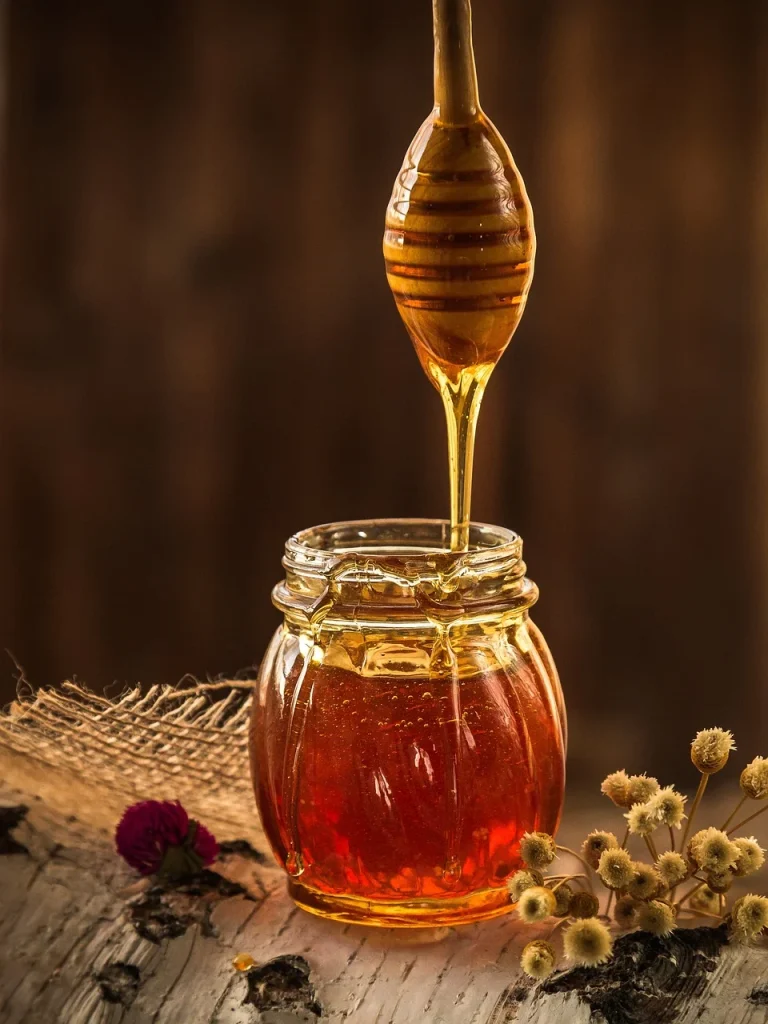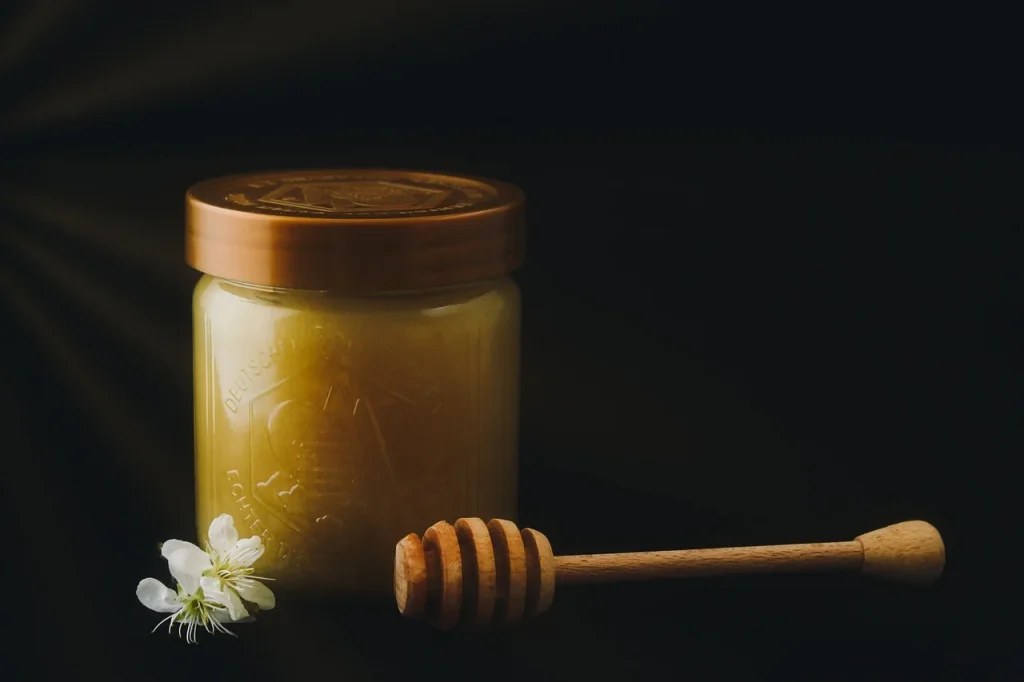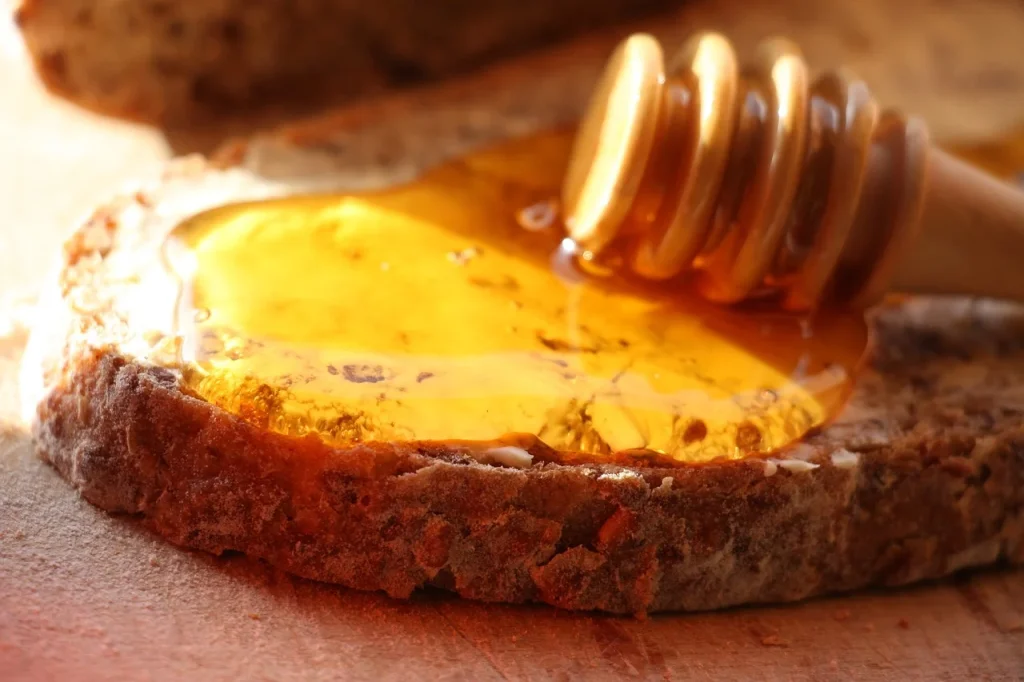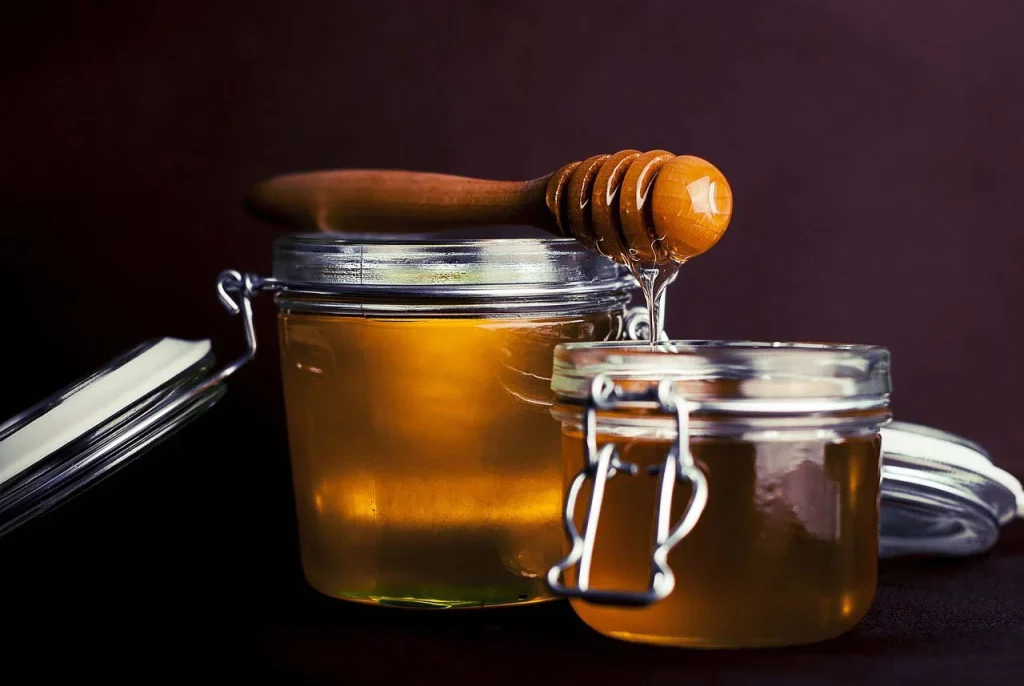Honey, that golden liquid produced by our busy bee friends, has more secrets than a hive has cells! This remarkable nectar has been around since ancient times, serving not just as a sweet treat but also as a part of many cultural traditions around the world.
Whether it’s drizzled over your morning toast or mixed into soothing teas, honey never fails to add a dash of delight. And who knew something made by insects could taste so good? Ready to dive into the sticky world of honey? Let’s start our journey.
Life is the flower for which love is the honey.
Victor Hugo
Honey Facts
Let’s start with some interesting facts. Read carefully, because I created a quiz for you at the end of this page to test your knowledge. Don’t disappoint me.
- Honey never spoils when stored in an airtight container, with jars over 3,000 years old being found edible in ancient tombs.
- The colors can vary dramatically, from nearly colorless to dark brown, depending on the botanical sources used by the bees.
- Bees must travel approximately 55,000 miles and visit 2 million flowers to produce just one pound of it.
- A single bee produces about 1/12th of a teaspoon in her lifetime.
- Rock paintings in Spain suggest humans have been harvesting this product for at least 8,000 years.
- Its antibacterial properties arise from an enzyme that produces hydrogen peroxide, a known disinfectant.
- Manuka, a type renowned for its health benefits, contains unique antibacterial components not found in other varieties.
- The flavor profiles can be as complex as those found in wine, influenced by regional flora and climatic conditions.
- It can contain traces of metals like gold and silver, as bees collect materials from environments that may carry these particles.
- Hydroxymethylfurfural (HMF) is a compound that forms in it when heated, and its levels are used to measure freshness and quality.
- Ancient Olympic athletes would eat this product to enhance performance, a practice rooted in its high natural sugar content.
- The viscosity changes dramatically with temperature; warming it can make it easier to pour, while cooling does the opposite.
- Crystallization doesn’t indicate spoilage but is a natural process that can be reversed by gently warming the jar.

- Bees communicate through dances to inform each other about the directions and distances to sources of nectar and pollen.
- The fermentation of it produces mead, one of the oldest alcoholic drinks known to humanity, often referred to as “honey wine.”
- Propolis, a resinous mixture produced by bees using sap and beeswax, often contains antibacterial properties similar to those of honey.
- Beeswax, a byproduct of honey production, is used in cosmetics, pharmaceuticals, and as a food coating.
- It is denser and weighs more than the same volume of water due to its high sugar content.
- Albert Einstein once speculated that if bees disappeared from Earth, humans would follow shortly after due to the collapse of food chains that rely on pollination.
- The distinct aroma of some types of it can be attributed to small amounts of compounds also found in fruits and flowers.
- In ancient Egypt, people paid their taxes with it, which was considered highly valuable.
- It’s used in some hospitals as a treatment for wounds and burns due to its effective healing properties.
- Bees must maintain a constant temperature of about 95 degrees Fahrenheit in the hive to process and reduce the moisture content in nectar.
- The whitish foam sometimes seen on the surface is simply air bubbles trapped during the bottling process.
- Allergies can be mitigated by consuming local honey, which contains pollen spores that can help build immunity.
- The North American Bear Center reports that black bears prefer this over berries when given the choice due to its high calorie content.
- During World War I, soldiers used honey to treat their wounds because of its antibacterial and healing properties.
- Avocado blossoms produce a dark, rich variety that is lesser-known but highly valued for its robust flavor.

- The ripening process involves bees fanning their wings inside the hive to evaporate excess moisture from nectar.
- Exposure to repetitive heating and cooling can degrade its quality, affecting both flavor and beneficial properties.
- To measure its purity, scientists check for the presence of specific types of pollen and enzymes that can’t be synthetically replicated.
- Floral sources can include trees, herbs, and garden flowers, with each contributing to the unique flavor profile.
- It has been used in medicinal practices across various cultures, including Ayurveda and traditional Chinese medicine.
- It takes about eight bees all their life to make one teaspoonful.
- Buckwheat honey has higher antioxidant levels than some lighter varieties.
- Starvation among bees is a real threat during long winters or when there are insufficient food sources nearby.
- Unusual but real, certain types can produce hallucinogenic effects, known as “mad honey,” due to specific neurotoxins in the nectar collected.
- Conservation efforts often promote beekeeping, even in urban areas, to support bee populations and biodiversity.

- Under microscopes, different types of this product reveal intricate crystal patterns shaped by the variety and concentration of sugars.
- Due to its moisture-absorbing properties, it is an excellent ingredient for baking, keeping pastries fresh longer.
- The wings of bees beat about 200 times per second to provide the air circulation necessary for processing honey.
- Diastase, an enzyme found in fresh honey, helps in breaking down starch into sugars, which is beneficial for digestion.
- The therapeutic uses of it are acknowledged by several health organizations, including the World Health Organization.
- Smoke from beekeeper’s smokers calms bees, making it easier to extract it without harming the colony.
- Temperature and humidity control are crucial in beekeeping to maintain the hive’s health and optimize production.
- Bees wax, another byproduct, has applications ranging from waterproofing to candle making.
- Despite its sweetness, it has a complex chemical makeup, including amino acids, vitamins, and trace enzymes.
- In rural Nepal, honey hunters climb cliffs to harvest wild honey from the nests of giant honeybees.
- Comb is considered a gourmet delicacy, featuring edible beeswax filled with it.
- The precise patterns of its flavors and textures are often compared to fine wines, influenced by terroir—a term usually used to describe the environmental conditions that affect the characteristics of grapes.
Honey Myths

Now that we’ve explored the facts, let’s clear up some common misconceptions. In the next section, we’ll separate the truth from the myths surrounding honey.
- Honey Never Spoils
Under the right conditions, honey can remain stable for centuries. It’s known that honey found in ancient Egyptian tombs was still edible. Honey’s longevity is attributed to its low moisture content and acidic pH, which are inhospitable to bacteria and microorganisms. - Honey Is Healthier Than Sugar
It is often perceived as healthier, but it is still high in calories and sugar. It contains beneficial nutrients and antioxidants not found in table sugar; however, moderation is advised as overconsumption can lead to health issues. - All Honey Is Natural and Organic
Not all honey is created equal. The label “organic” is only applicable if the production meets specific organic standards set by governing bodies. Regular honey might be processed or mixed with other ingredients. - Honey Can Be Used Freely by Diabetics
It is commonly believed that it is safer for diabetics, but it still significantly raises blood sugar levels. Care should be taken, and consultation with healthcare professionals is advised before including it in a diabetic diet. - Honey Is Always Pure
The purity of honey can be compromised. Adulteration with substances like syrup is a common issue on the market. Authenticity and purity are sometimes assured by certifications, but they are not always guaranteed without proper testing and verification.
No products found.
Honey Quotes

We continue our journey into the fascinating world of honey through the words of those who have been captivated by its golden allure.
Words are sweet, but they can never replace food.
Okakura Kakuzo
Okakura Kakuzo uses this quote to emphasize the practical limits of beautiful words, comparing them to the sweetness of honey, which cannot substitute sustenance.
The keeping of bees is like the direction of sunbeams.
Henry David Thoreau
Henry David Thoreau draws a comparison between the natural and seemingly effortless process of managing bees and harnessing the simple power of sunlight, highlighting the organic beauty of beekeeping.
Honey is sweet but the bee stings.
Jamaican Proverb
This Jamaican proverb uses the allure of honey and the danger of bee stings as a metaphor for life’s pleasures that often come with risks.
If you want to gather honey, don’t kick over the beehive.
Dale Carnegie
Dale Carnegie’s advice underscores the importance of approaching sensitive situations with care to achieve beneficial outcomes without causing conflict.
The sweetness of honey does not comfort a man who longs for sugar.
African Proverb
This African proverb expresses the idea that specific desires cannot be satisfied with substitutes, no matter how pleasant those substitutes may be.
Honey FAQ

As we conclude our journey, we’re now entering the FAQ section. Keep these details in mind—they’re crucial for the quiz that follows.
- Will honey hurt dogs?
Not usually, but be cautious. Honey is safe for dogs in small amounts, but it’s high in sugar, which isn’t ideal for your furry friend, especially if they are overweight or have diabetes. Also, puppies shouldn’t eat honey since it can contain bacteria harmful to their immature immune systems. - Can honey freeze?
Technically, yes, but it’s a slow process. It is a sugar-rich substance, so while it can become solid at very low temperatures, it doesn’t freeze solid like water. Instead, it thickens and becomes more viscous. - Why does honey crystallize?
It crystallizes because it’s a super-saturated sugar solution. Over time, the glucose in honey tends to separate from the water and form crystals. It’s a natural process, and that doesn’t mean the honey has gone bad. In fact, you can return it to its smooth state by gently warming it up. - Will honey break a fast?
Yes, it will. It is a form of sugar and has calories, so consuming it will break a fast by causing your body to leave the fasting state and start metabolizing the sugars, thus ending the process of fasting. - Can honey cause diabetes?
Not directly, but moderation is key. It is still a form of sugar, and consuming high amounts of sugar can contribute to an increased risk of developing type 2 diabetes, especially if combined with an overall unhealthy diet and lack of exercise. Use it sparingly and wisely!
No products found.
Honey Trivia

Welcome to our sweetest quiz yet! Dive into our honey trivia, and beware: if you don’t get any answers right, you’ll be crowned the Queen Bee of Blunders!
Honey Merch
If you are a true honey fan, then you definitely need to check out our merchandise. You can find T-shirts, hoodies, mugs, and tote bags for your favorite designs. Feel free to check out all the other designs in our shop.
Conclusion
In conclusion, honey isn’t just a sweet treat; it’s a powerhouse of health benefits and historical significance. From soothing sore throats to being used as a currency in ancient times, honey’s versatility is unmatched.
Remember, while honey can sweeten your day, it’s the hardworking bees that deserve the real credit. So next time you enjoy this golden delight, think of the incredible journey it has made from flower to spoon. Till next time, stay curious and explore more. Cheers.


